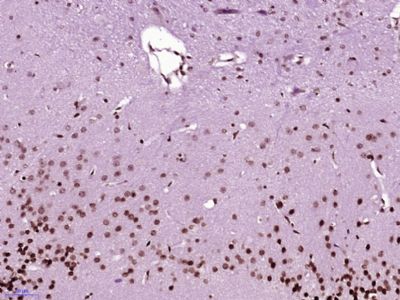NFKBIL1 Polyclonal Antibody
Purified Rabbit Polyclonal Antibody (Pab)
- SPECIFICATION
- CITATIONS
- PROTOCOLS
- BACKGROUND

Application
| IHC-P, IHC-F, IF, ICC, E |
|---|---|
| Primary Accession | Q9UBC1 |
| Reactivity | Rat, Pig, Dog, Bovine |
| Host | Rabbit |
| Clonality | Polyclonal |
| Calculated MW | 43 KDa |
| Physical State | Liquid |
| Immunogen | KLH conjugated synthetic peptide derived from human NFKBIL1 |
| Epitope Specificity | 81-180/381 |
| Isotype | IgG |
| Purity | affinity purified by Protein A |
| Buffer | 0.01M TBS (pH7.4) with 1% BSA, 0.02% Proclin300 and 50% Glycerol. |
| SIMILARITY | Contains 2 ANK repeats. |
| DISEASE | Defects in NFKBIL1 are a cause of susceptibility to rheumatoid arthritis (RA) [MIM:180300]. It is a systemic inflammatory disease with autoimmune features and a complex genetic component. It primarily affects the joints and is characterized by inflammatory changes in the synovial membranes and articular structures, widespread fibrinoid degeneration of the collagen fibers in mesenchymal tissues, and by atrophy and rarefaction of bony structures. |
| Important Note | This product as supplied is intended for research use only, not for use in human, therapeutic or diagnostic applications. |
| Background Descriptions | This gene encodes a divergent member of the I-kappa-B family of proteins. Its function has not been determined. The gene lies within the major histocompatibility complex (MHC) class I region on chromosome 6. Multiple transcript variants encoding different isoforms have been found for this gene. [provided by RefSeq, Jan 2009] |
| Gene ID | 4795 |
|---|---|
| Other Names | NF-kappa-B inhibitor-like protein 1, Inhibitor of kappa B-like protein, I-kappa-B-like protein, IkappaBL, Nuclear factor of kappa light polypeptide gene enhancer in B-cells inhibitor-like 1, NFKBIL1, IKBL |
| Target/Specificity | Detected in different cell types including monocytes, T-cells, B-cells and hepatocytes. |
| Dilution | IHC-P=1:100-500,IHC-F=1:100-500,ICC=1:100-500,IF=1:100-500,ELISA=1:5000-10000 |
| Storage | Store at -20 ℃ for one year. Avoid repeated freeze/thaw cycles. When reconstituted in sterile pH 7.4 0.01M PBS or diluent of antibody the antibody is stable for at least two weeks at 2-4 ℃. |
| Name | NFKBIL1 |
|---|---|
| Synonyms | IKBL |
| Function | Involved in the regulation of innate immune response. Acts as negative regulator of Toll-like receptor and interferon-regulatory factor (IRF) signaling pathways. Contributes to the negative regulation of transcriptional activation of NF-kappa-B target genes in response to endogenous proinflammatory stimuli. |
| Cellular Location | Nucleus. Note=Nuclear localization with a speckled expression pattern in some cells. Colocalizes with CACTIN in the nucleus |
| Tissue Location | Detected in different cell types including monocytes, T-cells, B-cells and hepatocytes |

Thousands of laboratories across the world have published research that depended on the performance of antibodies from Abcepta to advance their research. Check out links to articles that cite our products in major peer-reviewed journals, organized by research category.
info@abcepta.com, and receive a free "I Love Antibodies" mug.
Provided below are standard protocols that you may find useful for product applications.
If you have used an Abcepta product and would like to share how it has performed, please click on the "Submit Review" button and provide the requested information. Our staff will examine and post your review and contact you if needed.
If you have any additional inquiries please email technical services at tech@abcepta.com.













 Foundational characteristics of cancer include proliferation, angiogenesis, migration, evasion of apoptosis, and cellular immortality. Find key markers for these cellular processes and antibodies to detect them.
Foundational characteristics of cancer include proliferation, angiogenesis, migration, evasion of apoptosis, and cellular immortality. Find key markers for these cellular processes and antibodies to detect them. The SUMOplot™ Analysis Program predicts and scores sumoylation sites in your protein. SUMOylation is a post-translational modification involved in various cellular processes, such as nuclear-cytosolic transport, transcriptional regulation, apoptosis, protein stability, response to stress, and progression through the cell cycle.
The SUMOplot™ Analysis Program predicts and scores sumoylation sites in your protein. SUMOylation is a post-translational modification involved in various cellular processes, such as nuclear-cytosolic transport, transcriptional regulation, apoptosis, protein stability, response to stress, and progression through the cell cycle. The Autophagy Receptor Motif Plotter predicts and scores autophagy receptor binding sites in your protein. Identifying proteins connected to this pathway is critical to understanding the role of autophagy in physiological as well as pathological processes such as development, differentiation, neurodegenerative diseases, stress, infection, and cancer.
The Autophagy Receptor Motif Plotter predicts and scores autophagy receptor binding sites in your protein. Identifying proteins connected to this pathway is critical to understanding the role of autophagy in physiological as well as pathological processes such as development, differentiation, neurodegenerative diseases, stress, infection, and cancer.


